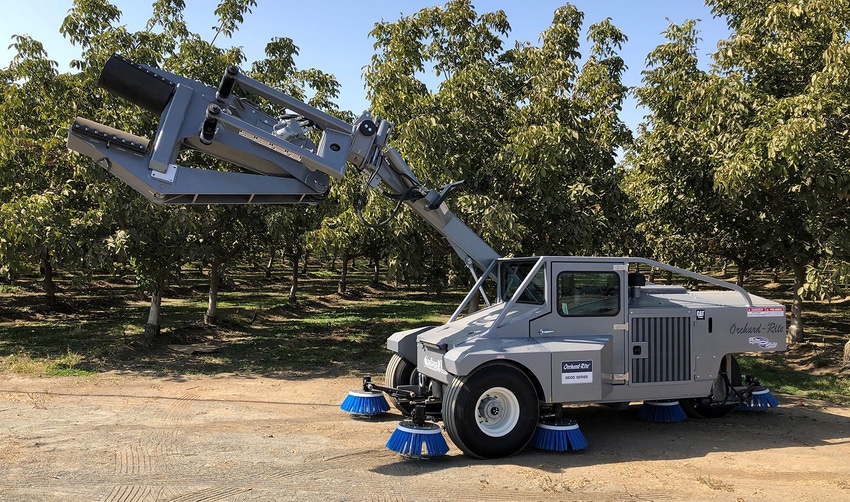
If you put some music to the next phase of the tree nut season, "Whole Lotta Shakin' Going On" by Jerry Lee Lewis and "Good Vibrations" by the Beach Boys are a couple of appropriate tunes that come to mind. It's that time of the year when California's almond trees give up product and this year should be a busy one with an 18% increase expected from last year's record-setting crop.
The tree-shaking portion of the industry is hustling to keep up, according to Pacific Distributing Inc.'s Emin Dahliwal, whose company supplies Orchard-Rite shakers like the straight-down-the-row Bullet or the Monoboom with its refined shake pattern designed to clear larger trees faster.
"I'm in constant motion nowadays," says the salesman. "We've opened up extra shop capacity and brought more technicians in and we're selling more machines than we did last year."
Procedurally, a shaker unit clamps to the tree, applying a vibrational force which transfers to the nut which disconnects at the abscission layer and falls to the ground. Shake timing traditionally occurs after the completion of kernel weight accumulation, but before hulls are completely dry.
According to TheAlmondDoctor.com: "Shaking should begin when hulls are still green and 100% of the nuts are half-to-two-thirds of the way split — the point of maximum weight accumulation. Correct timing should lead to an increase in nut removal."
Taking a quick break between demonstrations of both scaffold and trunk shaking, Dahliwal noted the simple, repetitive process does require some sophistication, "Each nut variety requires different osculating acceleration patterns to release nuts from the tree while the trees themselves can withstand only so much energy transfer before becoming damaged."
He has spent his share of time in the cab being bombarded by cascading nuts.
"There's a proximity sensor in our machines that opens 8 or 10 or 12 inches and basically you just keep moving forward," he said. "It's basic repetition. Move forward. Clamp. Shake forcefully enough to dislodge the nuts without harming the tree. Move on to the next one. We're able to get 20 to 25 acres done in a day when tree trunks are of comparable sizes."
What's it like being in the cab and being pelted by every tree you shake…comparable to a light hailstorm? "It's not that bad, depending on the type of trees you're shaking. You can still hear the nuts fall on you, but shaker units today are much quieter than back when. And they're airtight to prevent taking a dust bath."
Newer models are better
It's the difference between night and day for those who shake and shred on a daily basis.
Luis Becerra is a driver for fifth-generation, family-owned Efird Ag Enterprises in Caruthers, some 1,300 acres of almonds, walnuts, and winegrapes in the Central Valley.
"Maybe in the old shakers, where the noise and dust required you to wear protective equipment like coveralls and a face mask in temperatures of 105 degrees, you'd feel like you were being shot at by a machine gun with nuts falling on the cab all day long," he says.
"You can't imagine how truly uncomfortable it was back then. But with the newer, quieter, air-cooled shaker cabs, those old days are gone forever — and I don't miss them."
For more news on tree nuts as reported by growers and farm advisors, subscribe to the Tree Nut Farm Press e-newsletter.
Read more about:
AlmondsAbout the Author(s)
You May Also Like




